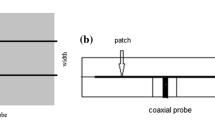Abstract
In this paper, the simulation and experimental studies of input characteristics as well as near field distribution of cylindrical dielectric resonator antenna (CDRA) and specific absorption rate (SAR) distribution in a homogeneous phantom muscle medium in close proximity with the antenna are reported in C-band of microwave frequencies. The simulation study has been carried out using Ansoft HFSS 3-D simulation software. The experimental SAR distribution has been obtained using two 50\(\Omega \) L-shaped and straight coaxial probes and Agilent make 3 Hz–50 GHz spectrum analyzer. The simulated results for input characteristics of the CDRA and SAR distribution in the phantom muscle medium due to the antenna are compared with the respective experimental results.






Similar content being viewed by others
References
Okoniewski, M., & Stuchly, M. A. (1996). A study of the handset antenna and human body interaction. IEEE Transaction on Microwave Theory and Techniques, 44, 1855–1864.
Pradier, A., Lautru, D., Wong, M. F., Fouad, V. H., & Wiart, J. (2005). Rigorous evolution of specific absorption rate (SAR) induced in a multilayer biological structure. European Conference on Wireless Technology, 3, 197–200.
Zainud-Deen, S. H., El-Deen, E., Sharshar, H. A., & Binyamin, M. A. (2007). Design of UMTS dielectric resonator antenna for mobile phone including the biological effects. 2007 Proceedings of URSI 24th National Radio Science Conference (NRSC)(pp. C35:1–8). Faculty of Engineering, Ain Shams University, Egypt.
Lee, T.H., Abd-Alhameed, R.A., & Excell, P. S. (2005). New dielectric resonator antenna design for mobile handsets. 2005 Proceedings of International Union of Radio Science General Assembly (URSI GA ’05) http://rp.iszf.irk.ru/hawk/URSI2005/pdf/BP.10(01068).pdf.
Palikruru, V. K., Sonoda, K., Surenran, R., & Jantunen, H. (2010). BST-COC composite based rectangular dielectric resonator antenna (DRA) for 2.4-GHz wrist applications. Progress in electromagnetics research C, 16, 195–205.
Gangwar, R. K., Singh, S. P., & Kumar, D. (2010). Wideband dual segment cylindrical dielectric resonator antenna terminated in a bio-medium. Microwave Review, 16, 14–21.
Gangwar, R. K., Singh, S. P., & Kumar, D. (2010). Wideband dual segment rectangular dielectric resonator antenna terminated in a bio-medium. 4th International Conference on Communications and Information Technology, (CIT-2010). Corfu Island, Greece, 22–25 July 2010, 64–68.
Gangwar, R. K., Singh, S. P., & Kumar, D. (2011). SAR distribution in a bio-medium in close proximity with rectangular dielectric resonator antenna. Progress in Electromagnetics Research B, 31, 157–173.
Gangwar, R. K., Singh, S. P., & Kumar, D. (2011). Modified dual segment rectangular dielectric resonator antenna terminated in a bio-medium. International Journal of Communications, Network and Systyems, 4, 377–383.
Gangwar, R. K., Singh, S. P., & Kumar, D. (2012). SAR distribution in a bio-medium in close proximity with dual segment cylindrical dielectric resonator antenna. Journal of Medical Engineering and Technology, 36, 199–204.
User Manual, Ansoft High Frequency Structure Simulator (HFSS), Ver. 11.0, Ansoft Corp., 2007.
Mongia, R. K., & Bhartia, P. (1994). DRA- A review and general design relation for resonant frequency and bandwidth. International Journal of Microwave and Millimeter Wave Computer -Aided Engineering, 4, 230–247.
Kishk, A. A., Glisson, A. W., & Junker, G .P. (1999). Study of broadband dielectric resonator antennas. Antenna Application, Symposium. pp. 45–68.
Kishk, A. A., Glisson, A. W., & Kajfez, D. (1993). Computed resonant frequency and far fields of isolated disks, IEEE Antennas Propogat. Soc. Int. Symp. Dig., Ann Arbor, MI, USA, pp. 408–411.
Zhou, J., Hara, D., & Kobayashi, T. (2006). Development of ultra wideband electromagnetic phantoms for antennas and propagation studies. In First European Conference on Antennas and Propagation (EuCAP-2006) pp. 1–6. doi:10.1109/EUCAP.2006.4584884.
Yadla, R. (2004). Novel designs For broadband and compact dielectric resonator antennas, Master thesis, Texas Tech University, Department of Electrical Engineering.
Ebrahimi-Ganjeh, M. A. (2006). Study of water bolus effect on SAR penetration depth and effective field size for local hyperthermia. Progress in Electromagnetics Research, 66, 111–124.
Guidelines, I. C. N. I. R. P. (1998). Guidelines for limiting exposure to time-varying electric, magnetic, and electromagnetic fields (up to 300 GHz). Health Physics, 74, 494–522.
Author information
Authors and Affiliations
Corresponding author
Rights and permissions
About this article
Cite this article
Gangwar, R.K., Singh, S.P. & Kumar, D. Cylindrical Dielectric Resonator Antenna Terminated in a Phantom Muscle Medium. Wireless Pers Commun 72, 843–855 (2013). https://doi.org/10.1007/s11277-013-1045-8
Published:
Issue Date:
DOI: https://doi.org/10.1007/s11277-013-1045-8




